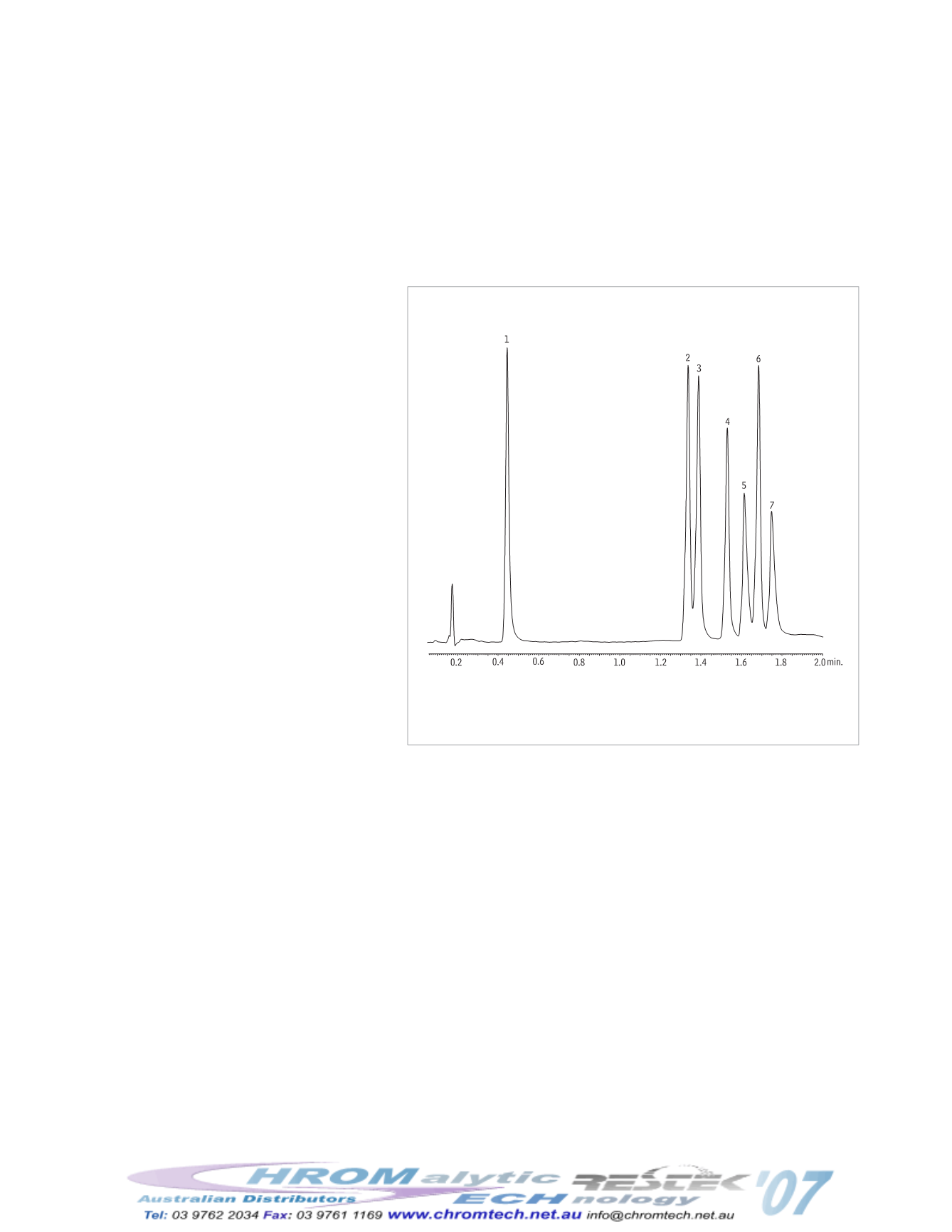

•
6
•
2007 vol. 3
Optimize Selectivity & Efficiency in UHPLC Separations
With More Stationary Phase Choices on 1.9μm Pinnacle™ DB HPLC Columns
By Rick Lake, Pharmaceutical Innovations Chemist
• Largest variety of stationary phases for UHPLC.
• Faster analyses, uncompromised chromatography.
• 100% Restek manufactured—from base silica to final packed column.
Since the late 1960s continual advancements have
been made in HPLC column technology, and over
time the trend has been toward smaller particle
sizes. This trend has led us to where we are today—
Ultra-High Performance Liquid Chromatography
(UHPLC). UHPLC is a milestone in the evolution
of LC in that columns packed with <2µm particles,
used with instrumentation capable of handling the
resulting high back pressures, make possible
extremely fast and efficient separations. UHPLC is
a very powerful tool for today’s practicing chro-
matographer, as it can significantly increase the
efficiency of a chromatographic separation. In
addition, the wider range of usable flow rates
makes high speed separations possible. However, in
light of this new technology, it is important that we
do not forget the importance of selectivity. In this
article, we will review the significance of selectivity
in obtaining acceptable resolution and demonstrate
how having choices in stationary phase allows you to
maximize the benefits of UHPLC.
In past articles we have discussed the physical
advantages that are driving interest in small particles,
mainly the influence of particle size on usable flow
rates and peak efficiency. Although small particles
have made faster separations possible, selectivity
has the greatest effect on resolution. Selectivity, in
turn, is governed predominantly by analyte interactions with both the stationary and mobile phases. UHPLC, through the use of small
particle columns, does maximize efficiency (e.g. theoretical plates), but the stationary phase is still the most important consideration
when attempting to resolve mixtures of compounds. Ideally, a stationary phase that produces optimum selectivity or allows for res-
olution of compounds in a timely manner should be selected.
Previously, some advantages of selectivity in specific separations have been noted. For example, the use of a unique Biphenyl sta-
tionary phase has shown excellent selectivity for aromatic or fused ring compounds. When using the Biphenyl stationary phase and
combining it with the heightened efficiencies of the 1.9µm Pinnacle™ DB column, we can produce highly selective and fast separations
of steroids (Figure 1). A Pinnacle™ DB 1.9µm Biphenyl column can separate a test mix of seven hormones in under 2 minutes, a feat
not possible through C18 selectivity.
Another example of unique selectivity available on a 1.9µm particle size column is the PFP Propyl (pentafluorphenyl propyl) stationary
phase for halogenated drug compounds. This phase is very selective and retentive for organohalogens or other compounds containing
basic or electronegative functionalities. To demonstrate heightened selectivity for halogenated drug compounds, we assayed a test mix
of eight benzodiazepines and two metabolites, a mix commonly assayed on a C18 colum, in just over 4 minutes with complete resolu-
tion (Figure 2). To get the same level of selectivity from a C18 column, a shallower gradient would be needed, prolonging the analysis
time. Since the selectivity of the Pinnacle™ DB 1.9µm PFP Propyl column elutes the benzodiazepines in quick succession, a simple
gradient still allows for the earlier elution of the more polar metabolites, while maintaining a fast overall run time.
Restek is committed to giving the practicing chromatographer choices, and has therefore sought to deliver the widest selection of sta-
tionary phases available with <2µm particle sizes. The goal of chromatography is always to resolve compounds of interest in the
fastest time possible. By combining the benefits of UHPLC with Restek’s complement of unique stationary phase choices, faster sep-
arations become a reality.
Figure 1
Restek’s 1.9 μm Pinnacle™ DB Biphenyl columns are highly
selective for steroids, making an extremely fast and selective analysis.
Peak List:
1. estriol
2. 17
β
-estradiol
3. 17
α
-estradiol
4. ethynyl estradiol
5. testosterone
6. estrone
7. norethindrone
Sample:
Inj.: 1µL; Conc.: 100µg/mL each component; Sample diluent: water:methanol (50:50)
Column:
1.9µm Pinnacle™ DB Biphenyl; Cat. #9409252; Dimensions: 50mm x 2.1mm;
Particle size: 1.9µm; Pore size: 140Å
Instrument:
Jasco X-LC
LC_PH0453
Conditions:
Mobile phase:
A: Water
B: Acetonitrile
Time (min) %B
0
30
1
30
3
70
Flow:
0.8mL/min.
Temp.:
30°C
Det.:
UV @ 220nm











